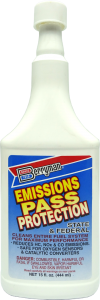I believe my Catalytic Converter may be on the verge of clogging, or is gaining build up in it. I noticed a product called CataClean that is put into the fuel tank, but I am very weary of many fuel additives, although I am a firm believer in your products. So I decided to look up the MSDS on CataClean and what do you know? It is VERY close, if not identical to your Fuel Injector Cleaner. My question is this, can a catalytic converter even be cleaned to some extent with the use of a fuel additive? They say their 'chemicals' stay in vapor form and that's how they clean the cat. Since the chemical make up of their product and your Fuel Injector Cleaner is so close, is it possible that by using your FI Cleaner in a concentrated amount (such as a 1/4 tanks of gas) could help clean the catalytic converter? Any help is appreciated and keep up the good work! Also, one other question, I know that MSDS doesn't require you to add Amines/PEA, but on your FI Cleaner, it says there is 'Polymer Amine Detergents' in it, but your MSDS doesn't list it, is it true it contains Amines?
2 Answers
 It’s possible that the catalytic converter could just be “overworked” from excessive emissions and/or exhaust-system deposits. If you have failed a vehicle emissions test or your “Check Engine” light just recently came on, try Berryman Emissions Pass Protection (part #0212).
This is a premium fuel additive that reduces hydrocarbon (“HC”), nitrogen oxides (“NOx”), and carbon monoxide (“CO”) emissions in part by cleaning up fuel injector, carburetor, intake valve, and combustion chamber deposits that can contribute to high emissions.
Additionally, it incorporates a combustion catalyst that helps reduce excessive emissions. Best of all, the product offers a money-back guarantee. If you are unable to locate the product at a local retailer, please call 1-800-433-1704 for assistance.
It’s possible that the catalytic converter could just be “overworked” from excessive emissions and/or exhaust-system deposits. If you have failed a vehicle emissions test or your “Check Engine” light just recently came on, try Berryman Emissions Pass Protection (part #0212).
This is a premium fuel additive that reduces hydrocarbon (“HC”), nitrogen oxides (“NOx”), and carbon monoxide (“CO”) emissions in part by cleaning up fuel injector, carburetor, intake valve, and combustion chamber deposits that can contribute to high emissions.
Additionally, it incorporates a combustion catalyst that helps reduce excessive emissions. Best of all, the product offers a money-back guarantee. If you are unable to locate the product at a local retailer, please call 1-800-433-1704 for assistance.We’ve taken the idea of a catalytic converter cleaner upstream to our additives suppliers and never received any positive responses. They always tell us that anything going into the combustion chamber of a properly tuned car comes out as CO2, O2, N2 (and none of those, of course, are cleaners). However, various conditions will change these combustion products to include HC (hydrocarbons), CO and NOx.
If, for instance, the unburned HCs persist for long enough—this can happen with old or bad spark plugs, dirty combustion chambers, etc.—then the cat can get too hot and start physically breaking apart over time. If this happens, no cleaner in the world can fix it and the component will have to be replaced.
That said the catalytic converter is “self cleaning” under certain conditions and should last the life of the car. If the “guts” are physically intact and there’s just some build up on the catalysts, then running a good fuel system cleaner and making sure the engine is properly tuned can help. This idealizes or “fixes” the combustion chamber products and allows the catalytic converter to start burning/shaking off the deposits and becoming active again.
From that standpoint, a catalytic converter cleaner is gimmicky. It’s cleaning the deposits in the fuel system and in the engine so that the exhaust is cleaner, not so that the exhaust contains cleaners. Reviews are mixed on the product you’ve mentioned, and there are two primary reasons why. One is the obvious—it just doesn’t work. The other is that people are trying to use the product to resurrect a cat that’s physically damaged inside.
My recommendation is two-fold. I would buy a can of our strongest gasoline fuel additive, B-12 Chemtool Total Fuel System Clean-Up (part #2616) and run it at 1 oz/gal. This will help fuel lines, fuel injectors, and intake valves (in non-direct-injection motors). After running out that tank and refueling with fresh gasoline, I would then warm up the car and run our Combustion Chamber Cleaner (part #2610). (While purchasing these two cleaners of ours will not be a substantial savings over the product you mentioned, they are excellent for their respective applications, and I personally use them both twice a year with great results.)
Once you’ve used all the Combustion Chamber Cleaner, that will complete the cleaning process of the fuel system, fuel injectors, intake valves, and combustion chamber. At that point, you’ll need to start driving the car, preferably on the highway. Initially, you’ll see white-smoke-laden exhaust. This is good because these are deposits being cast off. If you drive for at least 15 minutes (and preferably about 30 minutes) you’ll start burning off any deposits that have fouled the catalysts. This is only a “fix” though, if your engine is functioning properly. If not, you’ll start forming deposits again.
As for parts #0112, #1112, #2616 and #3012, all of these products contain specialized detergent packages designed specifically for their recommended applications. However, sometimes I’m not required to list things on the MSDS if a chemical present does not exceed a certain threshold, usually 1%.
Thanks for your loyalty in our products. Good luck!
Please login or Register to submit your answer
